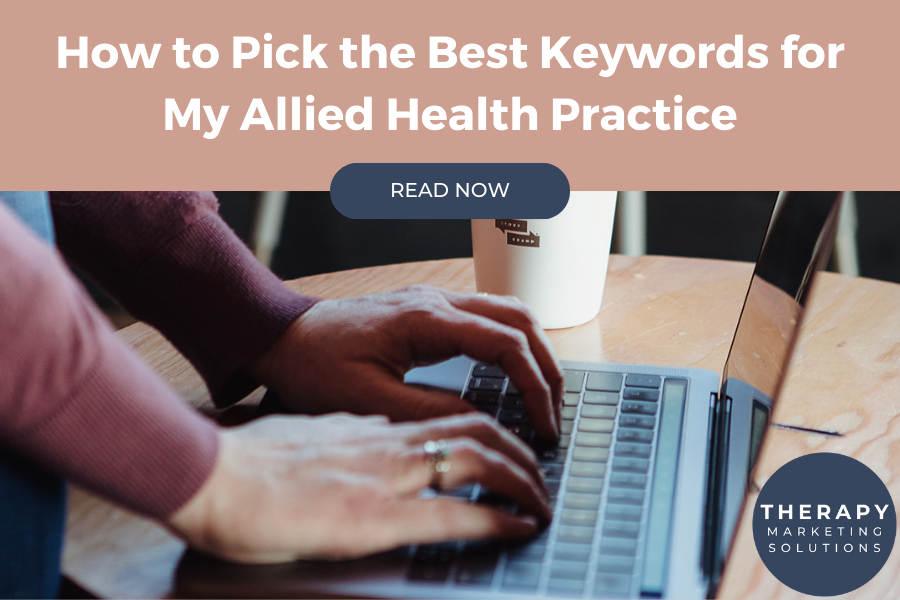Choosing keywords for your website can really feel like walking on a tightrope. On one hand, you’re aware of the importance of honing in on specific terms to boost your website’s visibility in search results. On the other hand, you fear narrowing your focus too much, potentially missing out on valuable opportunities. It’s a delicate balance between casting a wide net and targeting your ideal clients precisely. Selecting keywords for SEO purposes is indeed a challenge, but one that can yield many benefits for your practice’s online presence.
Today we are going to cover all that you need to know to choose the best keywords for your practice. But first, we want to express something so important now at the beginning in hopes that you will take it to heart and apply it as you read through the rest of the post. In selecting keywords and creating your website, maintaining a seamless flow within your website’s content is more important than anything else. While it’s crucial to integrate keywords strategically, it should never come at the expense of readability or natural language usage. Awkwardly stuffing keywords into your sentences or paragraphs can disrupt the user experience, leaving visitors scratching their heads in confusion. Remember, the primary goal is to provide valuable and engaging content that resonates with your audience. If a chosen keyword sounds out of place within a given context, you may want to reconsider and select a more fitting alternative. By prioritizing a seamless flow, you ensure that your website delivers a cohesive and enjoyable experience for every visitor. With that being said, let’s get to the good stuff.
Within keywords, there are 3 different types of keywords that all play different roles on your website: Primary, secondary, and additional keywords.
Primary Keywords
The primary keyword has a pivotal role in your allied health website. It serves as the cornerstone, representing the main topic or theme that encompasses your practice. This keyword plays a vital role in search engine optimization (SEO) as it guides search engines to understand the focus of your website’s content. When selecting a primary keyword, it is important to choose one that accurately reflects your practice’s unique message and aligns with the needs of your ideal client. Aim to integrate this keyword into crucial elements such as the page title, title tag, meta description, and headings. By skillfully choosing a primary keyword that resonates with your practice’s focus and incorporating it thoughtfully throughout your website, you establish a strong foundation for attracting relevant traffic and enhancing your online visibility.
Secondary Key Words
While the primary keyword sets the overarching theme of your allied health website, secondary keywords play a complementary role in enriching its content and expanding its relevance. Unlike the primary keyword, secondary keywords offer variations or related terms that support the main topic. Selecting 1-3 secondary keywords allows you to delve deeper into specific aspects of your practice or cater to the diverse search queries of your audience. When choosing secondary keywords, consider terms that align with the primary keyword and offer valuable insights or additional perspectives. For example, let’s say you are a Children’s Therapy Practice. Your keyword could be pediatric therapy and your secondary keywords could be occupational therapy for children, children’s behavioral therapy, and speech therapy for kids. Notice that the secondary keywords elaborate on your practice, but support the primary keyword. In doing this, you enhance the breadth and comprehensiveness of your website’s content, ultimately attracting a wider range of visitors and further boosting your SEO rankings.
Additional Keywords
Additional keywords, also known as long-tail keywords or specific phrases, play a significant role in enhancing the visibility and relevance of your allied health website. These keywords go beyond the primary and secondary keywords and provide further depth and specificity to your content. Including 1-4 additional keywords allows you to target niche topics, address specific conditions, or cater to the unique needs of your audience. You’ve got a unique message and this is your way to talk to your ideal clients.
Now, you’re probably thinking, “Wow, that is a lot of words. How am I supposed to incorporate all these while still sounding natural?” As a general rule, if your homepage, blog, or article exceeds 1000 words, aim for approximately 8 keywords, while anything shorter should have a minimum of 3 keywords. This should help you avoid stuffiness in your content.
Recommended Tools for Finding Keywords
Here are just a few free websites that will help you see keywords and their rankings
Choosing Keywords is a Process
While keywords do hold a significant role in optimizing your practice’s website, it’s important to remember that finding the perfect combination is a journey. Don’t be discouraged if it takes time to discover the most effective words for your practice. It’s a process of trial and error, where you can continuously test different keywords, monitor analytics, and learn from the data to see what resonates with your audience. There is a free version of Yoast, a tool that offers guidance and insights for keyword optimization. You can use this to help you as you start out. With each step in your website optimization, you gain valuable knowledge and refine your approach, ultimately shaping your site into the best it can be. Embrace this journey with confidence, knowing that your dedication will lead to a fantastic website that attracts and serves those who seek your help.

